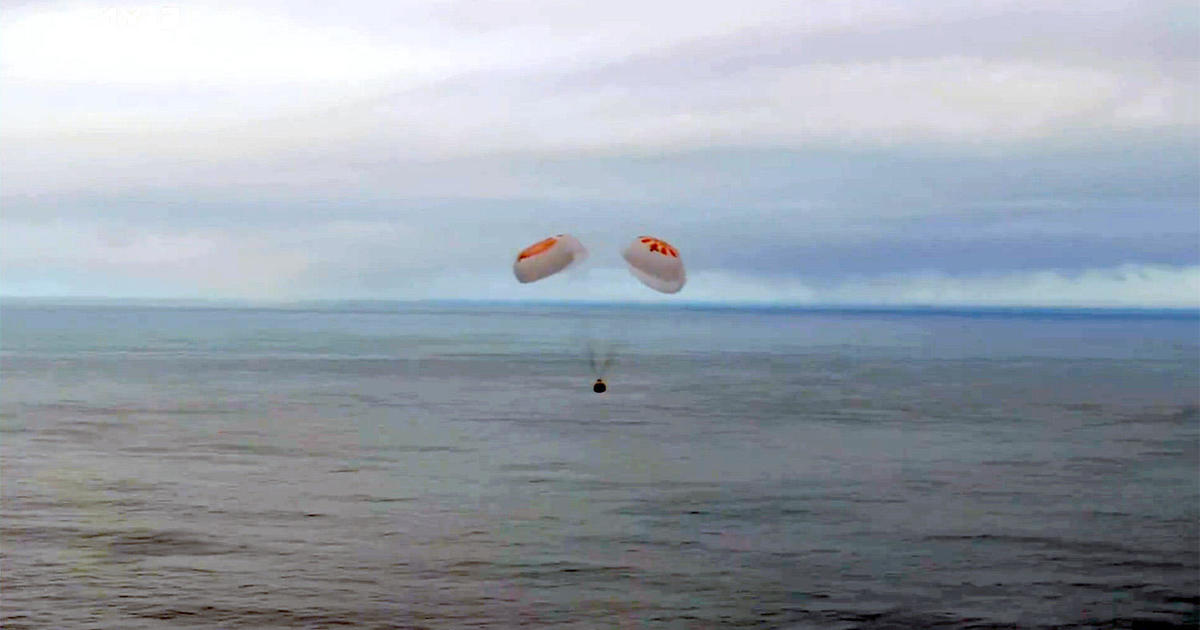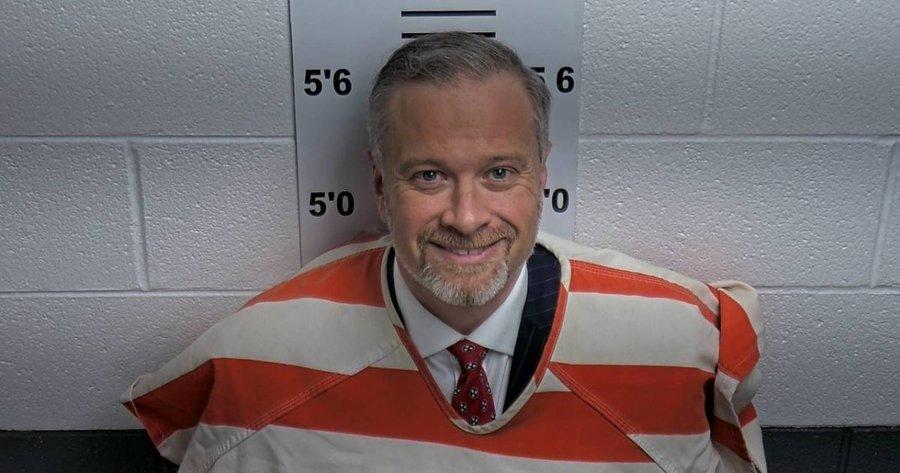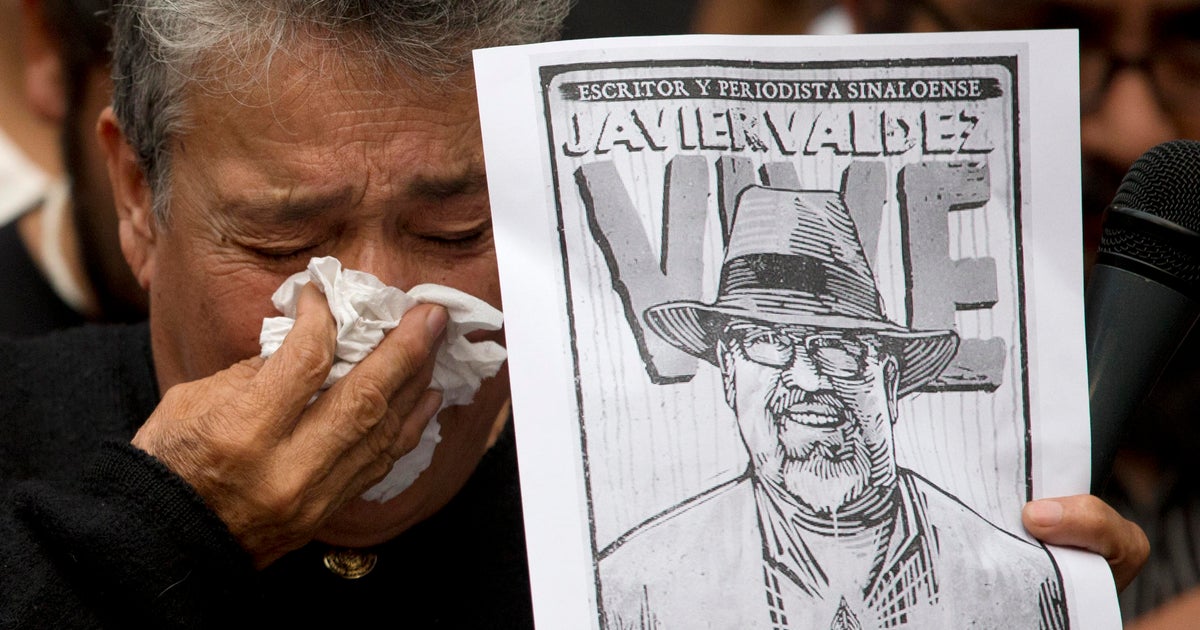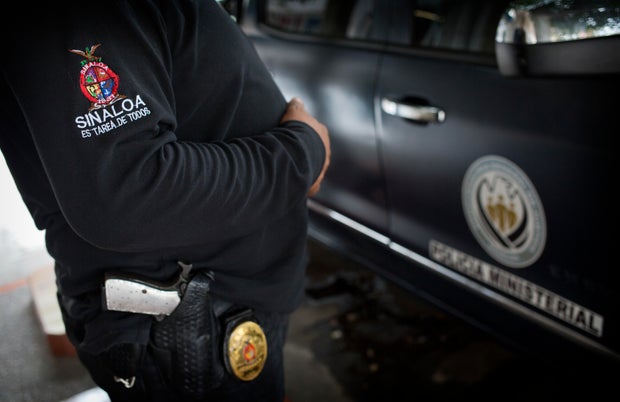CBS News
Private-sector astronauts return to Earth after extended space station visit

A commercially chartered Crew Dragon spacecraft plunged into the atmosphere and splashed down off the east coast of Florida Friday, bringing four private astronauts back to Earth after an extended stay aboard the International Space Station.
With commander Michael López-Alegría and Italian co-pilot Walter Villadei monitoring cockpit displays, flanked by Swedish flier Marcus Wandt and Turkey’s Alper Gezeravci, the Crew Dragon’s braking rockets fired at 7:42 a.m. EST, slowing the ship just enough to drop the far side of its orbit deep into the atmosphere.
SpaceX web stream
Descending along a southwest-to-northeast trajectory across Central America and the Florida peninsula, the Crew Dragon’s heat shield protected the craft from temperatures higher than 3,000 degrees as the capsule rapidly decelerated in a blaze of atmospheric friction.
Approaching the landing zone east of Daytona Beach, two small drogue chutes deployed to stabilize the spacecraft, followed by the ship’s four main parachutes, which lowered the Crew Dragon to a gentle splashdown at 8:30 a.m. Mission duration was 21 days and 15 hours.
“Welcome home,” a flight controller radioed. “Thanks for flying SpaceX.”
“It was our pleasure,” López-Alegría replied. Despite the capsule’s motion on a gently rolling sea, he reported all four crew members were feeling good as they began their readjustment to gravity after three weeks off planet.
A SpaceX recovery ship was standing by and within about a half hour, the capsule was hauled aboard so technicians could open its side hatch and help the returning space fliers get out, one at a time, for initial medical checks.
SpaceX web stream
All four were in good spirits, able to stand upright with the assistance of recovery personnel as they began getting used to the unfamiliar tug of gravity.
It was the third — and longest — “private astronaut mission” chartered by Houston-based Axiom Space in a program sanctioned by NASA to encourage private-sector use of the International Space Station.
Axiom is using the Crew Dragon flights to ISS to develop procedures and experience needed to operate a commercial space station the company plans to start building over the next few years.
Launched Jan. 18 from the Kennedy Space Center, López-Alegría, a retired NASA astronaut, Villadei, Wandt and Gezeravci originally planned to spend just two weeks aboard the station, returning to Earth on Feb. 3.
But high winds in both the Gulf of Mexico and the Atlantic Ocean splashdown zones forced the crew to remain in orbit an additional six days when all was said and done, undocking Wednesday and then flying on their own for nearly two days to reach the proper trajectory for Friday’s re-entry.
SpaceX web stream
The descent to splashdown appeared to go off without a hitch, clearing the way for NASA and SpaceX to press ahead with two major missions amid a steady string of Starlink launches.
On Feb. 14, SpaceX plans to launch a robotic moon lander built by Intuitive Machines of Houston in a project funded by NASA to collect data on conditions near the lunar south pole as the agency ramps up toward astronaut landings in the next few years.
Once that mission is is off the ground, SpaceX will shift gears and ready another Falcon 9 for launch at the end of the month from the same Kennedy Space Center pad to carry four long-duration crew members to the International Space Station.
Crew 8 commander Matthew Dominick, Michael Barratt, Jeanette Epps and cosmonaut Alexander Grebenkin will join Crew 7 commander Jasmin Moghbeli, European Space Agency astronaut Andreas Mogensen, Japanese astronaut Satoshi Furukawa and cosmonaut Konstantin Borisov aboard the ISS, along with Russian cosmonauts Oleg Kononenko, Nikolai Chub and NASA’s Loral O’Hara.
Crew 7 was launched last August follow by Kononenko, Chub and O’Hara last September.
Moghbeli and her crewmates plan to undock and head home in early March. The ISS crew then will await the late March arrival of a Russian Soyuz spacecraft carrying veteran cosmonaut Oleg Novitskiy, Belarus guest flier Marina Vasilevskaya and NASA veteran Tracy Dyson.
Novitskiy, Vasilevskaya and O’Hara will return to Earth on April 2, leaving Dyson behind on the ISS with Kononenko and Chub, who are both spending a full year in space. Dyson will join them for return to Earth in September.
CBS News
Tennessee DA accused of firing multiple times at fugitive, hitting home with woman and her 3 children inside

A district attorney in Tennessee is facing a reckless endangerment charge after shooting at a fugitive several times and hitting a home that had a woman and her three children inside.
The Tennessee Bureau of Investigation announced the grand jury charge Monday against District Attorney Chris Stanford. His district covers Van Buren and Warren counties.
The indictment says that as the incident unfolded in Smithville on Nov. 21, a bullet Stanford shot from his handgun went through a front porch patio chair, through an exterior wall and into the living room wall of the home. The woman and children weren’t hurt.
Smithville is about 60 miles southeast of Nashville.
The indictment says that Stanford fired the shot “unlawfully, intentionally and recklessly.” There was no immediate threat to him or others, he wasn’t aiming the handgun, and “just held it out and shot” without using the gun’s sights, the indictment adds.
Following his indictment, Stanford surrendered at the DeKalb County Jail and was released after posting a $10,000 bond, TBI said. A message left with Stanton’s office was not immediately returned Tuesday.
The Warren County Sheriff’s Office described the circumstances leading to the incident last month. In a social media post, it said authorities were pursuing suspects after finding three dead bodies at a house and at an adjacent building.
The suspects were sighted in DeKalb County, the sheriff’s office said. One of them was taken into custody without incident. Stanford and other law enforcement officials chased the other suspect, who was a passenger in a car, the office said.
While trying to help the suspect flee, the driver struck a homeland security officer with the car, the sheriff’s office said.
In a statement last month to CBS affiliate WTVF-TV, Stanford said he fired shots in response to the homeland security agent being hit. No one was shot when Stanford fired his gun. The homeland security officer was injured and taken to the hospital, according to a social media post by District Attorney Bryant Dunaway.
“The vehicle then drove toward me and others, accelerating quickly. I fired my service weapon in defense of myself and others at the scene. Based upon my training and the circumstances that presented themselves, I believe my actions were necessary and justified,” Stanford said.
Stanford also told the news station he has a state law enforcement certification to carry his weapon at all times.
The two suspects in the three deaths were taken into custody and charged with criminal homicide, while the driver, also taken into custody, faces felony evading arrest and aggravated assault charged, according to the sheriff’s office.
Stanford will make an appearance in court on Jan. 7, WTVF reported. Since he showed up at the scene and fired his weapon, he is now a witness and cannot prosecute the triple murder in his own county, the station reported.
CBS News
Accused mastermind of journalist’s murder wanted by Mexico — but U.S. has called him a “protected witness”

Mexico has asked the United States to extradite the suspected mastermind behind the murder of journalist Javier Valdez after he was arrested on drug charges, the attorney general said.
Damaso Lopez Serrano — who the Justice Department says is known as “Mini Lic” — is accused of ordering the 2017 killing of Valdez, an award-winning journalist and AFP contributor who covered the narcotics trade.
The alleged former high-ranking member of the Sinaloa Cartel was arrested on Friday in Virginia on charges of trafficking fentanyl. Lopez Serrano is the son of Damaso Lopez Nunez, who launched a struggle for control of the cartel following the arrest of its leader, Joaquin “El Chapo” Guzman.
Mexico’s Attorney General Alejandro Gertz described Lopez Serrano as the “mastermind” behind Valdez’s murder.
“We have already prosecuted the rest of the perpetrators and they are in jail,” he told a news conference.
Valdez was shot and killed in his car on May 15, 2017 in the Sinaloa state capital of Culiacan near the offices of his weekly newspaper Riodoce.
Enric Marti / AP
Investigators believe Lopez Serrano ordered the hit because he was angry about information published by Valdez about the Sinaloa Cartel’s internal power struggles.
Mexico has made several extradition requests for Lopez Serrano, who surrendered to U.S. authorities in July 2017 for drug trafficking and cooperated in exchange for a reduced sentence. At the time, the U.S. Drug Enforcement Administration said Lopez Serrano was “believed to be the highest-ranking Mexican cartel leader ever to self-surrender in the United States.”
He was released from prison on parole in 2022.
Gertz said that Mexico had asked “on countless occasions” for Lopez Serrano to be handed over, but Washington declined because he had become a “protected witness” and “was giving them a lot of information.”
He voiced hope that with Lopez Serrano’s latest arrest “there are more than enough reasons” for the United States to finally grant Mexico’s request.
Rebecca Blackwell / AP
Wracked by violence related to drug trafficking, Mexico is one of the world’s most dangerous countries for journalists, news advocacy groups say.
Reporters Without Borders says more than 150 newspeople have been killed in Mexico since 1994 — and 2022 was one of the deadliest years ever for journalists in Mexico, with at least 15 killed.
Media workers are regularly targeted in Mexico, often in direct reprisal for their work covering topics like corruption and the country’s notoriously violent drug traffickers.
Most recently, in October, gunmen killed a journalist whose Facebook news page covered the violent western Mexico state of Michoacan. Then less than 24 hours later, an entertainment reporter in the western city of Colima was killed inside a restaurant she owned.
CBS News
2 sisters, 7 years apart in age, also receive heart transplants 7 years apart in Chicago

CHICAGO (CBS) — Two sisters have grateful hearts after they both received heart transplants at the same age—seven years apart.
Younger sister Meredith Everhart and older sister Abbey Cannon are now bonded by a genetic condition and a second chance at life.
“What’s ironic is that when she needed a heart transplant, was exactly the same age I needed a heart transplant,” said Cannon. “Seven years apart in age, seven years apart within 30 days of transplant, and our birthdays are within 30 days.”
The sisters share a special bond of getting a second chance at life, which they both received at the age of 38 years old.
Both sisters suffer from hypertrophic cardiomyopathy—otherwise known as HCM.
The genetic condition is a form of heart disease that causes the heart muscle to thicken.
In 2012, Cannon had chest pain. She was misdiagnosed in Nashville, Tennessee, and got a second opinion at Northwestern Medicine in 2016.
“Within six months, I was inpatient on an aortic balloon pump waiting for a heart,” Cannon said. “I ended up getting my heart 32 days later, So my date is February 27, 2017.”
Just months after Cannon’s transplant, Everhart was diagnosed with HCM too. She tried medication and participated in clinical trials, but her condition kept getting worse.”
“For me, it was, she’s right—I was in denial for a long time,” said Everhart, “and I didn’t want to be sick. I was in my 20s. I was in my early 30’s. I was like, this is not happening. I saw how bad she suffered.”
In May 2022, Everhart got COVID-19, and it sent her into heart failure.
She was added to the transplant list one year later.
“I got the call on January 29 of this year, 2024, and it’s been a journey,” Everhart said. “It’s been fantastic though. Northwestern has been great.”
Cannon said she can’t stress enough how important it is to become an organ donor.
“Had we not had someone that gave that most selfless gift, neither of us would be here,” she said.













